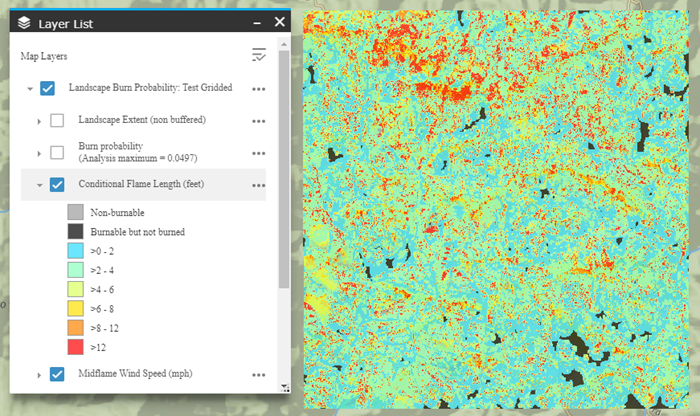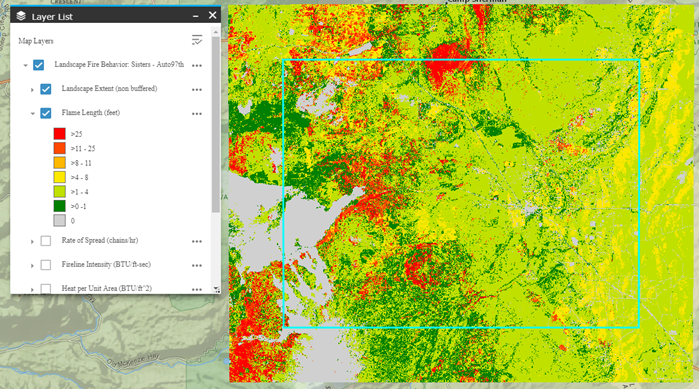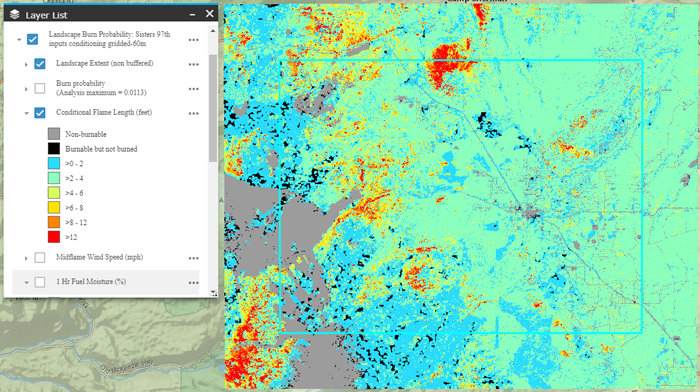Conditional Flame Length
Important! Different than FSim - IFTDSS LBP calculates burn probability and conditional flame length for a fixed set of weather conditions for a single burn period. The Large Fire Simulation Model (FSim, Finney and others 2011) used in many national, regional, and unit level assessments, calculates results based on variable weather inputs for fires burning multiple days throughout an entire fire season.
See the LBP technical documentation for more detail.
Conditional Flame Length (CFL) is viewable in Map Studio, in Reports, and available in the download package. Conditional Flame Length is an estimate of the mean flame length for all the fires that burn a given point on the landscape during a LBP model run. Conditional flame length from LBP is typically lower than flame length coming from Landscape Fire Behavior. This is because as LBP spreads fire across the landscape it includes heading, flanking and backing fire, whereas with Landscape Fire Behavior, fire is not spread across the landscape and only head fire is considered. Head fire typically has higher flame lengths than flanking or backing fire. In addition, conditional flame length is the mean of all fires encountered by a pixel versus a singular condition and can only have a maximum value of 25 feet (see the calculations section below for details).
Calculation
Conditional flame length is calculated as the sum product of the flame lengths across the six fire intensity levels (also known as Proportion of Flame Lengths).

Where:
FLPi is the probability of fire at a given intensity.
FLi is the mid-point of the given intensity level.
Because 25 ft is used as the midpoint value for the highest fire intensity level, conditional flame length has a maximum possible value of 25 ft. The table below shows an example of how the calculation is completed.
| Fire Intensity level flame length range (ft) | Mid-point flame length (ft) (FLi) | Proportion of Flame Length (FLPi) | FLi * FLPi |
|---|---|---|---|
| 0-2 ft | 1 ft | 0 | 0 |
| 2-4 ft | 3 ft | 0.077 | 0.231 |
| 4-6 ft | 5 ft | 0.292 | 1.46 |
| 6-8 ft | 7 ft | 0.542 | 3.794 |
| 8-12 ft | 10 ft | 0.089 | 0.89 |
| >12 ft | 25 ft | 0 | 0 |
| Conditional Flame Length (sum of FLi * FLPi) | 6.4 | ||
Display
Using the Identify widget shows the exact conditional flame length for a pixel and proportion of flame lengths. The image below shows the results for our CFL example in the above table.

In the Map Studio and Reports in IFTDSS conditional flame length is displayed with 8 distinct classes. The first two are for pixels that did not burn:
- Non-burnable means that pixels have a non-burnable fuel model and cannot burn.
- Burnable, but did not burn, means that the pixel has burnable fuels but did not burn. This can be because a fire never reached the pixel, or a fire reached the pixel or started within the pixel but it was unable to burn out of the pixel because the fire spread rate was too slow.
Note: Places on the landscape can be unburned for three reasons: 1) the location has a non-burnable fuel model, 2) fire never reached that location, or 3) an ignition started but did not burn out of the current pixel. These cases are presented differently in Map Studio and reports versus the GeoTIFF available for download. Non-burnable locations are denoted as such, “Non-burnable” in Map Studio and Reports, and are -1 in the GeoTIFF. Locations that the fire never reached or didn’t spread out of are “Burnable but not burned” in Map Studio and Reports, and are 0 in the GeoTIFF.
The remaining 6 classes match those of the fire intensity levels:
- >0-2 ft
- >2-4 ft
- >4-6 ft
- >6-8 ft
- >8-12 ft
- >12 ft

Difference Compared to Flame Length from Landscape Fire Behavior
Below, the Flame Length output from Landscape Fire Behavior completed with Auto97th inputs (top) is displayed with Conditional Flame Length from an LBP run with similar Auto97th inputs, 20% spotting and an 8 hr burn period (bottom).


Looking at the general patterns, the areas of highest and lowest flame lengths and conditional flame lengths are consistent between the two model outputs while the output values are different.
A point was selected from the north central section of the map that was represented by the highest flame length and conditional flame length categories respectively. Notice that the flame length from the Landscape Fire Behavior run is 54.6 ft versus 15.2 ft for conditional flame length from a LBP run.

Note: In the IFTDSS download package, Conditional Flame Length is represented in continuous values in feet. Where non-burnable pixels exist, the value is -1.